Pink Snow and the Climate
Air Date: Week of January 13, 2023
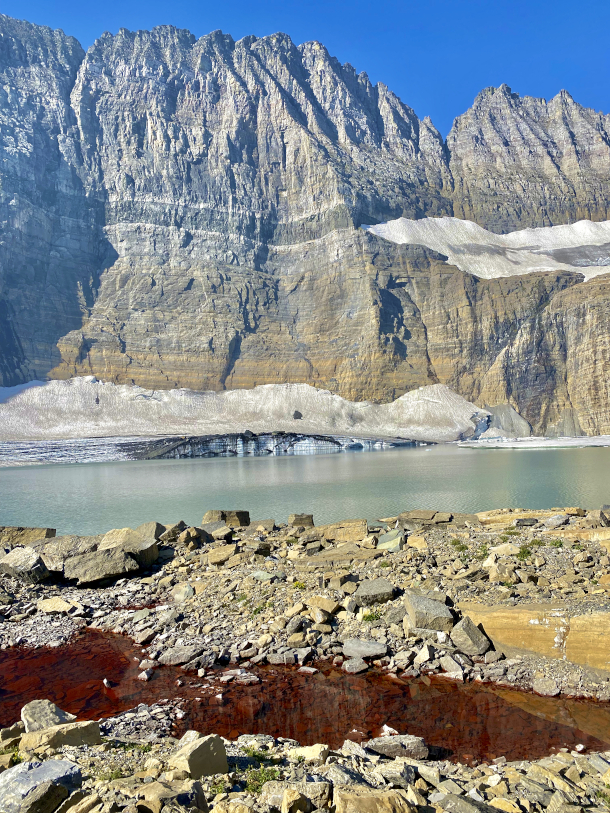
“Glacier blood” is another nickname for the melted remnants of pink snow. (Photo: Jim Elser)
Pink snow, also known as “watermelon snow” or “glacier blood,” is the result of a typically late summer bloom of pink colored algae that flourish in melting snow. And although snow algae are still very understudied, scientists are worried that darker snow will absorb more of the sun’s heat than white snow and cause the snowpack to melt more quickly. Jim Elser, a professor of ecology at the University of Montana, joins Host Bobby Bascomb to explain the implications for climate change and summertime water supplies that rely on steady runoff.
Transcript
CURWOOD: From PRX and the Jennifer and Ted Stanley Studios at the University of Massachusetts Boston, this is Living on Earth. I’m Steve Curwood.
BASCOMB: And I’m Bobby Bascomb. Parts of California are now drowning amid days of downpours. The sudden influx of rain could help pull the state out of record droughts but it’s too much too fast to store and fully absorb into the ground, especially in developed areas with engineered canals and levees designed to contain water and not allow it to soak into the soil naturally. Likewise, much of the American West relies on snow melt to fill lakes and streams and recharge aquifers but when the snow melts too quickly water simply runs off the land before it can be absorbed. Scientists have long worried about how climate change is causing snow to melt more quickly and now they have a new concern. Pink snow. Sometimes called “watermelon snow,” or “glacier blood” pink snow is the result of pink colored algae that flourish in melting snow. And although pink snow is still very understudied, scientists are worried that darker snow will absorb more of the sun’s heat than white snow and cause the snow pack to melt more quickly. That has important implications for climate change and summertime water supplies that rely on steady runoff. Here to explain is Jim Elser, a professor of ecology at the University of Montana. He joins us now, welcome to Living on Earth!
ELSER: Thanks for having me.
BASCOMB: So how would you describe pink snow for someone who's never seen it before?
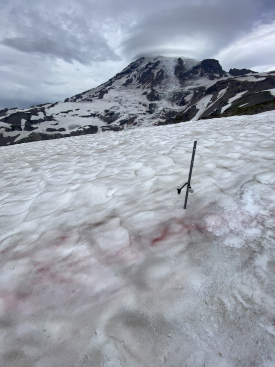
Snow algae thrive in high-altitude snow patches at just above freezing (Photo: Jim Elser)
ELSER: Well, I like to imagine the world's largest watermelon snow cone you've ever bought. It really literally looks like that, when you get close to it or pick it up, it looks like an Icee: pink, watermelon-y kind of a tinge, maybe sometimes along the orange side, but it looks like someone has spilled a snow cone maker down the side of the mountain. It's pretty strange.
BASCOMB: So how wide of an area are we talking about that would be pink?
ELSER: It'll depend. Sometimes it can be the entire, an entire snowfield in front of you, you know, you're looking at a 50, 100 meters of snow around you. And it's also sort of got this pink color to it. Very often, it'd be very patchy, it'll be a tiny little patch, maybe the size of a throw rug or something like that or smaller, or there'll be a whole sort of channel of it, you know, where the snow is a little bit lower in some depressions, and it'll be visibly red there and not so much anywhere else.
BASCOMB: And is there a part of the world where you're more likely to find this pink snow? Which mountains are we talking about here?
ELSER: It's worldwide. It's polar regions; best studied in the polar regions, especially in Greenland in the ice sheet and other areas in the Arctic; the snow algae are documented in the Antarctic, and they're found in mountains all around the world. It's a ubiquitous phenomenon. not well understood I'd say, as far as, you know, what controls its spatial distribution, or how dark it is, or which species necessarily it is. So those are still a lot of open questions, which is fun when you're a researcher, obviously.
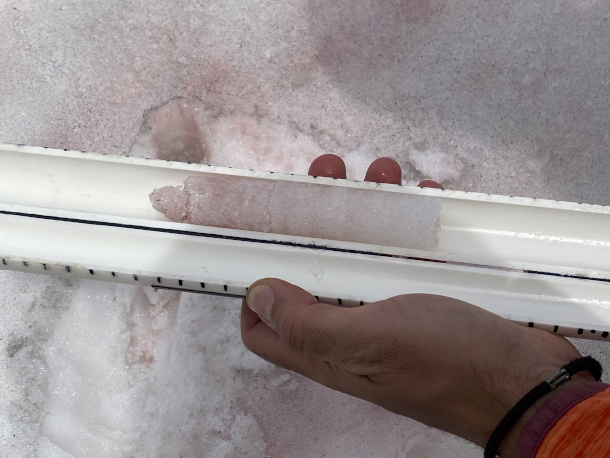
A snow core sample containing pink snow and the snow algae that causes it (Photo: Jim Elser)
BASCOMB: Yeah, I mean, it leads to a lot of questions that you can answer, a lot of research to be done.
ELSER: Or, or, struggle to answer! [LAUGHS]
BASCOMB: [LAUGHS] Well, I mean, if all the answers came easily, where's the fun in that, right? Anybody could do it.
ELSER: That's right, that's right.
BASCOMB: So why exactly is the snow pink? I understand that it's algae. But what's going on here?
ELSER: Yeah, well, paradoxically, pink snow algae or pink snow is generally caused, usually, by members of the green algae. Now that's confusing! "Green algae" is the sort of phrase we use to describe members of a certain type of algae. They're pink because they make red pigments, carotenoid pigments, like the ones you have in carrots, and they make those pigments probably to protect themselves against the extremely high light intensities that they experience at the surface of the snow. And so you're looking at carotenoids, that's why we see them as that red watermelon color.
BASCOMB: And what do they live off of? I mean, we're talking about very cold regions, snow, there's not a whole lot going on there to support life.
ELSER: Yeah, I know, that's, well it's sort of a extreme environment, except, you know, these are cryophiles: "cryo" meaning cold, "phile" meaning loving; they love the cold, actually, do best when it's cold. And you know, if you grow them in the lab, they do best when it's like two degrees centigrade, right, just a little bit above freezing. So they actually like it cold. In any case, so how do they make a living? Well, they're photosynthetic, so they're harvesting sunlight and using that to make sugar, the way that all sort of photosynthetic organisms do. Of course, there's a lot more to growing and making a big bloom than just getting light. They have to get nutrients, and especially nutrients like nitrogen and phosphorus, the same sort of stuff we put in fertilizers to make crops grow or our grass green. So there's nitrogen and phosphorus in snow -- snow is not just pure frozen water. It forms in, you know, snow forms in the atmosphere, gets nucleated around dust particles, and those have phosphorus and nitrogen in them. There's nitrogen oxides that are in the atmosphere that come out in snow, there's ammonia and urea from fertilizer that gets volatilized and put into the atmosphere and that comes out in snow. So the snow has different amounts of phosphorus and nitrogen in it and they are taking that up and using that to build their biomass. And so it's sort of like the same way algae have to make a living, the same way they do in lakes, right? They harvest the sun, they take nutrients from the water and they grow. It's the same sort of story with snow algae.
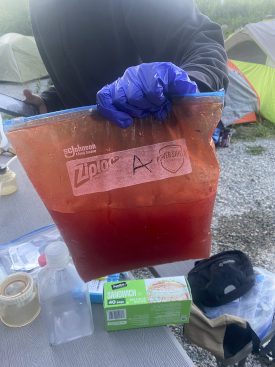
A bag of red snow algae collected for processing in the lab resembles watermelon juice (Photo: Jim Elser)
BASCOMB: So pink snow, it's more important to us than just this curiosity. Why is pink snow actually important to climate science?
ELSER: Great question. Yeah, so it is fascinating to learn about, obviously, but there are other dimensions of it. So for snow algae to grow, they need free water. They need unfrozen water to grow and take up nutrients in. And you know, under warmer conditions that, that obviously come in summer, you know, the snow melts, starts to melt a bit and the snow algae can grow to take up nutrients. And the more, the longer in the summer we have the warmer conditions, there's more free water availability, both seasonally but also day and night, right? So that free water availability allows the snow algae to metabolize and take up nutrients and proliferate. And then there's an interesting feedback further. And that is the snow algae obviously changes the color of the snow, makes it darker, changes the albedo. Scientists call the brightness of something the "albedo" -- how much incoming radiation from the sun is reflected back. And white snow is obviously reflecting everything back at you at all the wavelengths, that's what white light is. But when there's a lot of snow algae in the snow, it has a dark red color. That means it's only reflecting a lot of the red back, it's absorbing a lot of the other wavelengths. And that, that absorption changes the melting, warms the snow up a bit more. And so the snow algae's sort of affecting their own environment. And there's a little bit of a feedback that gets going there, right. So as they proliferate, they make it darker and the albedo goes down, absorbs more radiation, melts the snow a bit more. So we're concerned about snow algae proliferation, because it can change the rate at which snow and ice are melting in the cryosphere, the cryosphere being the frozen part of the, of the world.
BASCOMB: So the more pink snow you have, the more the snow warms quickly; the more warming you have, the more algae you have, the more pink snow you have, the more warming you have. It's, it's a positive feedback loop.
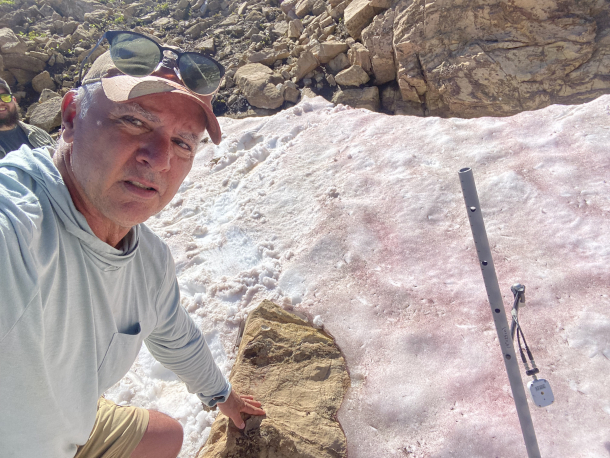
Jim Elser in the field while studying pink snow algae. (Photo: Jim Elser)
ELSER: Yeah, it's a little concerning. Yeah, that's right.
BASCOMB: And is that being accounted for in, you know, the big climate modeling that scientists are looking at?
ELSER: Not yet, I think there's been some calls for it to be incorporated. I think, you know, especially, you know, people who are just, who are trying to model snowpack with respect to like water output, right, that's needed for irrigation or other uses, right? Having more information, better understanding albedo effects of snow algae might be able to help us improve the modeling, even at the watershed scale of snow melt, and its timing. And at the global scale, yeah, I, you know, there's a lot of things that go into those models. I think that it would be useful, especially for those modeling the larger ice sheets, they're starting to incorporate the albedo effect. And they need to because I think it's been shown that 75% of the melting on the Greenland ice sheet is attributable to the albedo effects of glacier algae. So the Greenland ice sheet is getting quite dark. And it's mostly because of ice algae, not snow algae, like we're talking about, it's a different group of organisms, but it's a similar sort of story. So to understand the Greenland ice sheet, people are realizing that we need to understand the snow algae growing there. And there's a lot of people working on that problem right now, thankfully.
BASCOMB: Yeah, that's huge. That's absolutely huge. What do we know about this type of snow algae historically? And how can that information maybe inform us, you know, what we should be looking at going forward?

Postdoctoral researcher Pablo Almela Gomez of the University of Minnesota logs snow algae data in the field. (Photo: Jim Elser)
ELSER: Unfortunately, yeah, there's not, you know, historical monitoring of snow algae, it's, it's hard to monitor; it's in a difficult location. You know, you have to get back up in the mountains and unlike other ecological phenomena, like lake productivity or lake clarity, where we have some excellent records going back a century or so, and there are some forest ecosystems and grassland ecosystems which have very good long term data. There is no long term monitoring program for any snow algae. So we don't have really good records of snow algae abundance going back to know how it's changed or not. I, I'm wondering and thinking that paleolimnology methods, that is the study of the past through the sediment records of lakes, could help us. So if you're in a catchment with a high elevation lake that has, you know, snowpack in it and snow algae in it, then perhaps remains of those snow algae after the snow has melted find their way into the lake and get stored in the sediments. And so we might be able to reconstruct the history of snow algae in a catchment or in the set of catchments, if we can find a way to reconstruct the remains of snow algae in the sediments. We might, if we had, you know, be able to go back a bit with satellite, you can sometimes see, you know, pronounced blooms in satellite images. But even the resolution of those is pretty poor once we go back more than 20 or 30 years. So, we're sort of stuck in the "invisible present," as it's been called. So we don't really know whether snow algae is going up or down right now because we don't have any long term records.
BASCOMB: Jim Elser is a professor of ecology at the University of Montana and the Director of the Flathead Lake Biological Station. Jim, thank you for your time today.
ELSER: It's my pleasure.
Links
High Country News | “Pink Snow Is a Red Flag for the West’s Water”
Living on Earth wants to hear from you!
Living on Earth
62 Calef Highway, Suite 212
Lee, NH 03861
Telephone: 617-287-4121
E-mail: comments@loe.org
Newsletter [Click here]
Donate to Living on Earth!
Living on Earth is an independent media program and relies entirely on contributions from listeners and institutions supporting public service. Please donate now to preserve an independent environmental voice.
NewsletterLiving on Earth offers a weekly delivery of the show's rundown to your mailbox. Sign up for our newsletter today!
 Sailors For The Sea: Be the change you want to sea.
Sailors For The Sea: Be the change you want to sea.
 The Grantham Foundation for the Protection of the Environment: Committed to protecting and improving the health of the global environment.
The Grantham Foundation for the Protection of the Environment: Committed to protecting and improving the health of the global environment.
 Contribute to Living on Earth and receive, as our gift to you, an archival print of one of Mark Seth Lender's extraordinary wildlife photographs. Follow the link to see Mark's current collection of photographs.
Contribute to Living on Earth and receive, as our gift to you, an archival print of one of Mark Seth Lender's extraordinary wildlife photographs. Follow the link to see Mark's current collection of photographs.
 Buy a signed copy of Mark Seth Lender's book Smeagull the Seagull & support Living on Earth
Buy a signed copy of Mark Seth Lender's book Smeagull the Seagull & support Living on Earth

